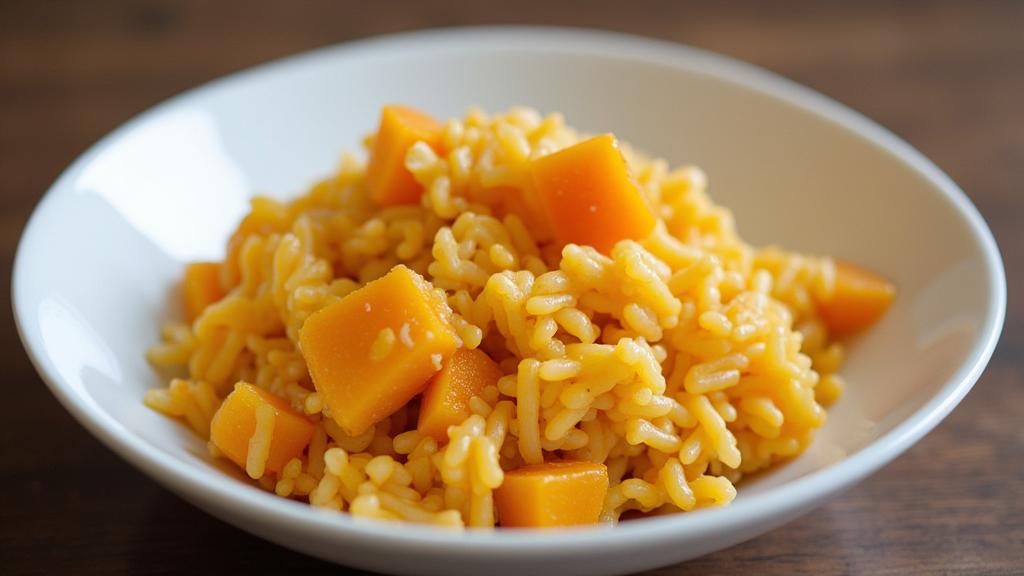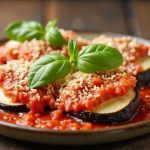Introduction
There’s something magical about a perfectly creamy butternut squash risotto that makes it one of my favorite comfort dishes to prepare. This recipe combines the natural sweetness of butternut squash with the rich, velvety texture of traditional risotto for a dish that’s both elegant and comforting. I’ve refined this recipe to be approachable for home cooks while delivering restaurant-quality results. Whether you’re cooking for a special occasion or just craving something warm and satisfying, this butternut squash risotto hits all the right notes.
Ingredients
- 1 medium butternut squash (about 2 pounds), peeled and cubed
- 6 cups vegetable or chicken stock
- 2 tablespoons olive oil
- 1 medium onion, finely diced
- 3 cloves garlic, minced
- 2 cups Arborio rice
- 1/2 cup dry white wine (optional)
- 1/2 cup freshly grated Parmesan cheese
- 2 tablespoons butter
- 2 tablespoons fresh sage, chopped
- Salt and freshly ground black pepper to taste
Instructions
- Heat your stock in a saucepan and keep it warm over low heat – this is crucial for proper risotto cooking.
- In a large skillet, roast the butternut squash cubes with a drizzle of olive oil at 400°F (200°C) for about 25 minutes until tender.
- While the squash roasts, heat olive oil in a large pot over medium heat. Add onions and cook until translucent (about 5 minutes).
- Add garlic and rice, stirring for 2-3 minutes until the rice is lightly toasted and fragrant.
- If using wine, add it now and stir until completely absorbed.
- Begin adding warm stock, one ladle at a time, stirring constantly. Wait for each addition to be absorbed before adding more.
- After about 18-20 minutes, when the rice is almost done, fold in the roasted squash.
- Add final ladle of stock, butter, and Parmesan cheese. Stir gently to combine.
- Finish with fresh sage, salt, and pepper to taste.
Cook Time and Serving Size
Prep Time: 20 minutes
Cook Time: 45 minutes
Total Time: 1 hour 5 minutes
Servings: 6
Recipe Notes
The key to perfect risotto is patience and attention. Keep these tips in mind:
- Your stock must be hot when adding it to the rice – cold stock will interrupt the cooking process.
- Don’t rush the process. Risotto needs constant attention and slow addition of liquid.
- You’ll know the risotto is done when the rice is creamy but still has a slight bite (al dente).
- If you need to make this dairy-free, you can skip the Parmesan and use additional olive oil instead of butter.
- Save a few roasted squash cubes for garnish to make the presentation more appealing.
- Leftover risotto will thicken considerably; when reheating, add a splash of hot stock or water to restore the creamy consistency.

Butternut Squash Risotto
This recipe combines the natural sweetness of butternut squash with the rich, velvety texture of traditional risotto for a dish that's both elegant and comforting.
Ingredients
- 1 medium butternut squash about 2 pounds, peeled and cubed
- 6 cups vegetable or chicken stock
- 2 tablespoons olive oil
- 1 medium onion finely diced
- 3 cloves garlic minced
- 2 cups Arborio rice
- 1/2 cup dry white wine optional
- 1/2 cup freshly grated Parmesan cheese
- 2 tablespoons butter
- 2 tablespoons fresh sage chopped
- Salt and freshly ground black pepper to taste
Instructions
- Heat your stock in a saucepan and keep it warm over low heat - this is crucial for proper risotto cooking.
- In a large skillet, roast the butternut squash cubes with a drizzle of olive oil at 400°F (200°C) for about 25 minutes until tender.
- While the squash roasts, heat olive oil in a large pot over medium heat. Add onions and cook until translucent (about 5 minutes).
- Add garlic and rice, stirring for 2-3 minutes until the rice is lightly toasted and fragrant.
- If using wine, add it now and stir until completely absorbed.
- Begin adding warm stock, one ladle at a time, stirring constantly. Wait for each addition to be absorbed before adding more.
- After about 18-20 minutes, when the rice is almost done, fold in the roasted squash.
- Add final ladle of stock, butter, and Parmesan cheese. Stir gently to combine.
- Finish with fresh sage, salt, and pepper to taste.



